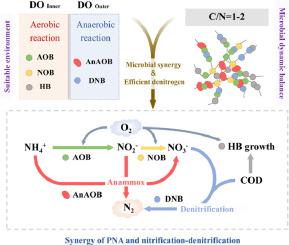Water Research ( IF 12.8 ) Pub Date : 2023-05-24 , DOI: 10.1016/j.watres.2023.120120 Enzhe Yang 1 , Jing Chen 2 , Ke Liu 3 , Jianhong Jiang 3 , Hong Wang 4 , Sha Wu 2 , Lixiu Shi 2 , Jingyi Jiang 2 , Eli Hendrik Sanjaya 5 , Hong Chen 2

|
Current research focuses on efficient single-stage nitrogen removal from organic matter wastewater using the partial nitritation-anammox (PNA) process. In this study, we constructed a single-stage partial nitritation-anammox and denitrification (SPNAD) system using a dissolved oxygen-differentiated airlift internal circulation reactor. The system was operated continuously for 364 days at 250 mg/L NH4+–N. During the operation, the COD/NH4+–N ratio (C/N) was increased from 0.5 to 4 (0.5, 1, 2, 3, and 4), and the aeration rate (AR) gradually increased. The results showed that the SPNAD system maintained efficient and stable operation at C/N = 1–2 and AR = 1.4–1.6 L/min, with an average total nitrogen removal efficiency of 87.2%. The removal pathways of pollutants in the system and the interactions between microbes were revealed by analyzing the changes in sludge characteristics and microbial community structure at different phases. As the influent C/N increased, the relative abundance of Nitrosomonas and Candidatus Brocadia decreased, and that of denitrifying bacteria, such as Denitratisoma, increased to 44%. The nitrogen removal pathway of the system gradually changed from autotrophic nitrogen removal to nitrification-denitrification. At the optimum C/N, the SPNAD system synergistically removed nitrogen through PNA and nitrification-denitrification. Overall, the unique reactor configuration facilitated the formation of dissolved oxygen compartments, providing a suitable environment for different microbes. An appropriate organic matter concentration maintained the dynamic stability of microbial growth and interactions. These enhance microbial synergy and enable efficient single-stage nitrogen removal.
中文翻译:

有机物胁迫下溶氧分化气升内循环反应器强化单级脱氮:脱氮途径与微生物相互作用
目前的研究重点是使用部分亚硝化-厌氧氨氧化(PNA)工艺从有机物废水中高效单级脱氮。在本研究中,我们利用溶解氧微分气升式内循环反应器构建了单级部分亚硝化-厌氧氨氧化反硝化(SPNAD)系统。系统在250 mg/L NH 4 + –N 条件下连续运行364天。运行过程中COD/NH 4 + –N比值(C/N)由0.5增加至4(0.5、1、2、3、4),曝气量(AR)逐渐增加。结果表明SPNAD系统在C/ N条件下保持高效稳定运行 = 1~2,AR = 1.4~1.6 L/min,平均总氮去除率为87.2%。通过分析不同阶段污泥特性和微生物群落结构的变化,揭示系统中污染物的去除途径和微生物之间的相互作用。随着进水C/N的增加,亚硝化单胞菌和Candidatus Brocadia的相对丰度下降,而反硝化细菌,如Denitatisoma的相对丰度下降,增加到44%。系统的脱氮途径逐渐由自养脱氮转变为硝化-反硝化。在最佳C/N下,SPNAD系统通过PNA和硝化-反硝化协同脱氮。总体而言,独特的反应器配置促进了溶解氧隔室的形成,为不同的微生物提供了合适的环境。适当的有机物浓度维持微生物生长和相互作用的动态稳定性。这些增强了微生物协同作用并实现了高效的单级脱氮。


























 京公网安备 11010802027423号
京公网安备 11010802027423号